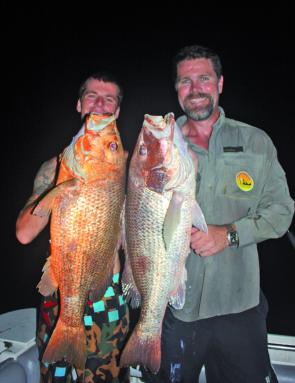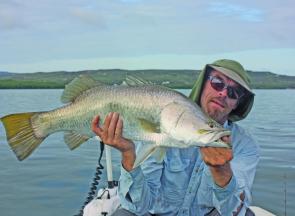The fishing action over the last few weeks has been outstanding and the hot bite is expected to continue throughout the next few months.
With the recent influx of southeasterly winds blowing, water temperatures have dropped below 30ºC for the first time in more than three months.
With a bit of luck the cooler waters will push the hoards of sharks back into the warmer waters of the Torres Strait easing the pressure on wallets of fishers who were averaging a loss of 20 rigs a night to sharks and barracuda.
These slightly cooler waters have ensured a vast improvement on the reef fishing scene with quality fish coming aboard thick and fast on recent trips. Deep water rubble patches, gutters and larger wonky holes have been firing at night with fantastic catches of large-mouth nannygai, spangled emperor, large reef jack and red emperor.
When searching for new areas to target the above species, we have found the most productive grounds consist of either a hard, rubble-like broken bottom or small car-sized mounts that protrude from the seabed.
Other notable areas that are often worth sounding around include isolated patches of rubble in the open paddock country between the areas of Big Uncharted and the Ribbon Reefs.
Most fish have been falling victim to large flesh and squid baits fished on a paternoster rig. Aussie pilchards have been taking their share of XOS trout and large-mouth nannies fished on a running sinker rig over small, deep water bombies during the late afternoon bite.
During The Lure Shop’s last offshore trip we were travelling to a mark that usually produces good red emperor when we came across a series of small gutters between 3-4ft deep. We marked the gutters on the GPS and decided to return on nightfall as there was very little life showing on the sounder.
We had a brief fish in shallower water that yielded a few good trout, then returned to the gutters at about 7pm. After spending nearly 20 minutes sounding around the mark during daylight hours, the amount of life that was now holding over the mark at nightfall was almost unbelievable.
We sent large squid baits to the bottom on a paternoster rig with two 10/0 Gamakatsu SL12s. Within seconds the 16N Torsa’s drag was getting a solid workout. After an intense fight a double header consisting of a 5kg large-mouth nannygai and 4kg reef jack hit the deck. With four people on board eight fish were landed from our first drop.
The action over the next hour was red hot with quality fish being landed all round. With a few fish in the esky, the soft plastic gear came out, once again proving small- and large-mouth nannies have a real soft spot for Berkley 7” Jerk Shads.
On nights like these colour choice of the Jerk Shads lures doesn’t matter too much, but on slower trips we have found the black caterpillar, orange tiger and blue pepper neon colours often produce fish when all other forms of fishing are slow.
The local inshore reefs and wrecks have been firing with the small tinnie brigade reporting excellent catches of coral trout, fingermark and Spanish mackerel.
Fingermark to nearly 90cm have been taken by drifting lightly weighted live sardines and fresh squid baits over the lesser-fished wrecks during the early hours of the morning.
By fishing in the predawn period, anglers have the added benefit of landing some tasty nannygai by-catch while waiting for the elusive trophy fingermark. When fishing these inshore wrecks and rubble patches live (or at least very fresh) bait is a prerequisite if you are targeting fingermark.
When fingermark break the 8kg mark, anglers have to remember these fish have been around for more than 50 odd years and are sure to have seen more than one hook in their life.
This form of fishing highlights the importance of neat bait presentation, however results can be improved through the usage of scented soft plastic such as Berkley 7” Jerk Shads or Squidy 130mm Flick Baits.
Please remember to limit your catch when targeting XOS fingermark. There is not a single species of fish that lives in North Queensland that pound for pound can pull harder than these large fingermark. Keep enough for a feed but please release what you don’t need. These fish are worth their weight in gold as future breeding stock.
The estuaries and headlands have also been producing quality barra, jack and queenfish with most fish falling to slowly rolled hardbodied lures that imitate the small sardines and hardiheads, which are prevalent throughout the local systems at this time of year.
One morning near the wharf we saw barra balling up hardiheads like a school of tuna working summer-bait around the headlands. These fish were literally free jumping like a pelagic fish and we have never seen so many barra in one place at a single time.
One fish that we caught regurgitated about 30 baitfish after we landed the fish, yet the barra still felt the urge inhale the Rapala SXR10 right down its throat.
With the recent rain falling from a few small cyclones, the local drains and culverts have been flowing freely. Not only has this accounted for many great barra sessions over the last month, it also ensures we will have a great year with plenty of 1m+ barramundi making their way into the various freshwater streams, lagoons and waterholes.
These waterholes are riddled with sunken timber and large rock bars that enable barra to survive the year and successfully avoid the ever-increasing pressure from commercial gill netters.
The local Annan River was fishing exceptionally well over the last few months however after various commercial boats have been legally netting the small and delicate system, captures of large breeding sized fish have slowed dramatically.
The rumours that Lakefield National Park would not open this year due to issues surrounding the ongoing maintenance of the roads into the park have been laid to rest. A media report released on 26 March cleared any element of doubt about the park roads reopening for the 2010 tourist season.
Although a definite opening date has not yet been released, it is expected to open as usual providing the weather conditions are suitable. Stay tuned for more updates about access to Cape York including Lakefield National Park in next month’s edition.
Feel free to drop into The Lure Shop if you have any questions regarding where to find the hot bite. The Lure Shop is located at 142 Charlotte Street, Cooktown. For any questions that you may have before your trip please do not hesitate to call us on (07) 4069 5396.
Until next month, stay safe on and off the water.
Reads: 3842
There are some cracker jacks like this one around in the estuaries at the moment.

Fingermark have been fishing well and are always a prized catch.

Barra have been feasting on the baitfish in the salt, but are still quite willing to take a lure.




